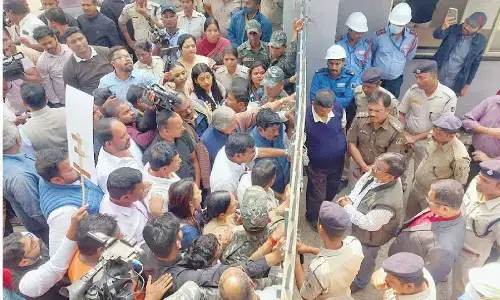Is Telangana a rich State?

Is Telangana a rich State? Chief Minister K Chandrashekar Rao’s statement that Telangana is a rich state has evoked a sharp political reaction. During the Telangana movement, it was repeatedly pointed out that Telangana region was pauperised under the Andhra rulers.
Chief Minister K Chandrashekar Rao’s statement that Telangana is a rich state has evoked a sharp political reaction. During the Telangana movement, it was repeatedly pointed out that Telangana region was pauperised under the Andhra rulers. How can it now become a prosperous state? His statement fails to clarify this. Normally central funds flow to poorer and under developed states. Any official claim that Telangana is a rich state would turn detrimental to the interests of the state.
Leaving aside the politics of this statement, one should analyse the reality. In November 2014, the Finance Minister of Telangana, Eatala Rajender, in his maiden budget speech said: “Opportunities were lost and problems accumulated as a result of deliberate neglect of Telangana.” How did this situation change in just a couple of months after bifurcation, making the state a prosperous one?
Is Telangana richer than India? The budget speech for the financial year 2014-15 answers this dilemma. The budget speech on page 5 said, ”The per capita income of the State at Rs 93,151 in 2013-14, though higher than the national average of Rs 74,920, masks wide variations across districts.
In Telangana, only three out of ten districts have per capita income higher than the national average. In the remaining seven districts, the per capita income is below the national average. As observed by numerous committees appointed by the Government of India, a majority of districts in Telangana continue to remain backward with nine out of 10 districts in the state covered under the Backward Regions Grant Fund (BRGF).”
Chief minister Chandrashekar Rao should have been aware of these facts quoted in the budget speech. But, still he declared Telangana as a richer state than before. A statement of fact is different from a stated ambition. Mixing of the two would send wrong signals.
The main reason for this uneven distribution of income across the districts is on account of large sectoral income variations. The Reinventing Telangana: Socio Economic Outlook 2014 observed, “The uneven regional distribution of income coupled with uneven growth is giving rise to widening regional disparities”.
The Per Capita District Domestic Product (DDP) is the lowest in districts like Mahabubnagar, Nizamabad and Warangal. Telangana like many parts of India also suffers from inequalities of different kinds. There exist substantial variations in the levels of development across districts of Telangana. The Gross District Domestic Product (GDDP) data indicates that three districts – Hyderabad, Ranga Reddy and Medak – together account for the half of the State income (GSDP), while the districts like Nizamabad, Adilabad, and Warangal share only 17 per cent of the State GSDP.
Therefore, any characterisaton of the State as a prosperous one by just looking at Hyderabad and its surroundings is an erroneous assumption.
The gap between the per capita income of the poorest and the richest districts is increasing over time. In fact, though Ranga Reddy and Medak are grouped along with Hyderabad as richer districts, these districts are not really richer. Only certain areas geographically closer to capital have higher income. This analysis reveals that the development is mainly concentrated in Hyderabad. Chief Minister is right when he said that the 14th Finance Commission characterised Telangana as a surplus State. But the concept of surplus and prosperity are not similar. The word surplus indicates a revenue–expenditure gap while the word rich indicates the income level.
Hyderabad mainly contributes to the surplus character of the state economy. The growing inter-district inequalities seriously undermine the integrity of the new state too. Telangana should learn from the experience of the united Andhra Pradesh.
Telangana lags behind in many indicators of social development for instance, Literacy rate of the state is lower than that of all India average. The state witnessed a slow growth of literacy. The rank of Telangana is 25 among the states in 2011. The proportion of households with no adult literate was 29 per cent in rural Telangana while it was only 18.7 per cent at all India level.
Besides literacy, health indicators form a vital measure of human development in any state. The Infant Mortality Rate (IMR) is a crucial indicator to assess the efficiency and effectiveness of health system. Though IMR has been declining over time, Telangana lags behind the progressive states like Kerala and Tamil Nadu.
The malnutrition levels in Telangana are at the higher end at 43 per cent among children below six years and over 80 per cent among adults, said Socio Economic Outlook 2014, a document presented to the Telangana legislature by the Government of Telangana ( page no. 84 ) the high incidence of malnutrition among children (less than 60 months) and chronic energy deficiency among women in the reproductive age group is major challenge in Telangana.
The Socio Economic Survey reveals another disturbing aspect of public health challenge in the state. The HIV epidemic remains a major public health challenge in Telangana state with an estimated two lakh persons living with HIV/AIDS. This official data reveals the high incidence of human poverty in the state.
Mere political rhetoric would not help the state and its people. The state of Telangana has challenges and opportunities. It’s the time for the government to overcome the challenges and harness the opportunities.
By: Prof K Nageshwar
Woman injured in stabbing attack in Tokyo, suspect at large
Bengal cop booked for murder over mysterious death of woman home guard, SIT to probe case
Staffer recalls horror of 7-kg gold robbery by armed gang in Karnataka’s Hunsur
25-Year-Old Airline Cabin Crew Member Dies At Gurugram Party; Police Begin Investigation













